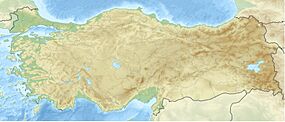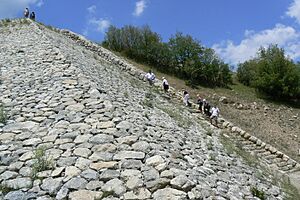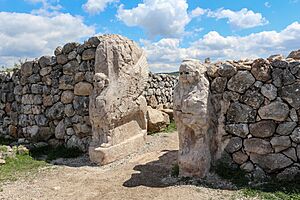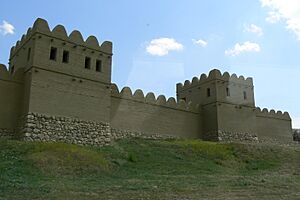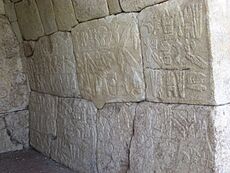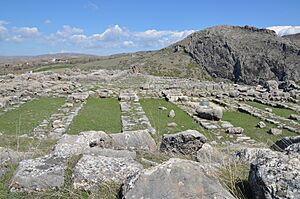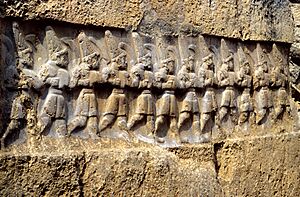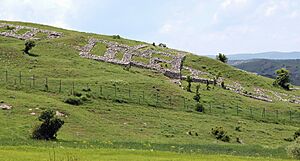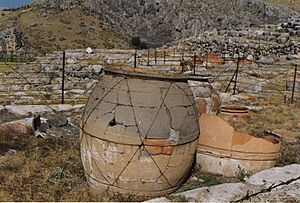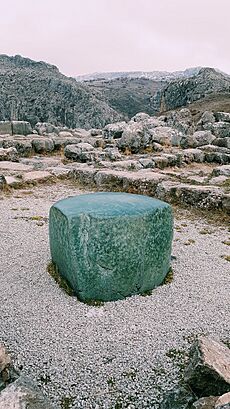Hattusa facts for kids
|
Hattuşaş (Turkish)
|
|
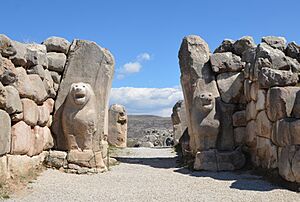
The Lion Gate in the south-west
|
|
| Location | Near Boğazkale, Çorum Province, Turkey |
|---|---|
| Region | Anatolia |
| Coordinates | 40°01′11″N 34°36′55″E / 40.01972°N 34.61528°E |
| Type | Settlement |
| History | |
| Founded | 6th millennium BC |
| Abandoned | c. 1200 BC |
| Periods | Bronze Age |
| Cultures | Hittite |
| Site notes | |
| Condition | In ruins |
| UNESCO World Heritage Site | |
| Official name | Hattusha: the Hittite Capital |
| Criteria | Cultural: i, ii, iii, iv |
| Inscription | 1986 (10th Session) |
| Area | 268.46 ha |
Hattusa was the amazing capital city of the Hittite Empire during the late Bronze Age. It was an important city for two different periods of time. Today, you can find its ruins near a modern town called Boğazkale in Turkey. This ancient city was located inside a big bend of the Kızılırmak River.
A French explorer named Charles Texier first brought attention to these ruins in 1834. Over the next hundred years, different archaeologists explored the site. In the 20th century, German groups started careful excavations that are still happening today. Because of its historical importance, Hattusa was added to the UNESCO World Heritage Site list in 1986. This means it's a special place protected for everyone to learn about.
Contents
History of Hattusa
The very first signs of people living in this area date back to about 6,000 BC. Later, around 3,000 BC, a group of people called the Hattian people built a settlement here. They called the place Hattush.
Around 1900-1800 BC, traders from Assyria (an ancient empire) set up a trading post in Hattush. They had their own special area in the lower part of the city.
The City's Destruction and Rebuilding
Around 1700 BC, Hattusa was burned down and destroyed. Archaeologists found a layer of burnt material that shows this event. It seems a king named Anitta from a nearby kingdom was responsible. He even put a curse on anyone who tried to rebuild Hattusa!
However, the city was rebuilt after this, perhaps by one of Anitta's sons.
Hattusa Becomes a Capital
In the early 1600s BC, a Hittite king named Labarna moved the capital from another city to Hattusa. He then changed his name to Hattusili I, which means "man from Hattusa." This made Hattusa the main city of the Hittite kingdom.
Over time, the capital moved a few times because of attacks from groups like the Kaskians. But in the mid-1200s BC, King Mursili III brought the capital back to Hattusa. It stayed the capital until the Hittite kingdom ended around 1200 BC.
Life in the City
At its biggest, Hattusa was a huge city, covering about 1.8 square kilometers (about 445 acres). It had an inner city and an outer city, both protected by strong, thick walls. These walls were built during the time of King Suppiluliuma I (around 1344–1322 BC).
The inner city was about 0.8 square kilometers (about 198 acres). It had a citadel (a fortress) with large government buildings and temples. The king's palace was on a high ridge called Büyükkale (Great Fortress). The city walls were over 6 kilometers (about 3.7 miles) long! They were very strong, with inner and outer layers.
The outer city was about 1 square kilometer (about 247 acres). It had fancy gates decorated with carvings of warriors, lions, and sphinxes. There were also four temples, other buildings, and homes. Outside the walls were cemeteries where people were buried after cremation.
Experts believe that at its peak, Hattusa had between 40,000 and 50,000 people living there. Most of the houses were made of wood and mud bricks, so they have disappeared over time. Only the stone parts of temples and palaces remain.
The End of Hattusa
Around 1200 BC, Hattusa was destroyed, and the Hittite Empire fell apart. This was part of a bigger event called the Bronze Age collapse, which affected many ancient civilizations. Evidence suggests that people slowly left Hattusa over several decades as the empire weakened. Some think a long drought might have happened. However, there are also signs that the city was finally destroyed by fire. After this, the site was empty until about 800 BC, when a small settlement appeared there.
Discovering Hattusa's Secrets
In 1834, the French archaeologist Charles Texier found the impressive ruins near the town of Boğazköy. He made maps and drawings of the site. Later, other explorers visited. In 1886, Georges Perrot was the first to suggest that Boğazköy was actually the lost Hittite capital of Hattusa.
In the late 1800s, archaeologists like Ernest Chantre started digging. Chantre found pieces of clay tablets with strange writing called cuneiform. Some of these texts were in the Akkadian language, and others were in what was later identified as the Hittite language.
Major Discoveries
In 1905, Hugo Winckler began major excavations. He found thousands of clay tablets, most of them in the Hittite language, which at the time could not be read. However, the few Akkadian texts confirmed that this site was indeed Hattusa. These tablets are incredibly important because they tell us so much about the Hittites.
Excavations continued for many years, stopping only during world wars. Since 1952, archaeologists have focused on different parts of the city, uncovering more and more of its secrets.
In 1986, a large metal tablet was found near the Sphinx Gate. This tablet, from the 1200s BC, contained a peace treaty between two kings. It is now in a museum in Ankara, Turkey. Another important find was a bronze sword from Mycenae (ancient Greece) found in 1991. It had an inscription in Akkadian.
The Royal Archives
One of the most exciting discoveries at Hattusa was the royal archives. These are collections of clay tablets from the Hittite Empire. They contain official letters, agreements, laws, religious rules, prophecies, and stories from the ancient Near East.
A very famous tablet, on display in the Istanbul Archaeology Museum, describes a peace treaty between the Hittites and the Egyptians under Ramesses II. This treaty was signed after the famous Battle of Kadesh in 1259 or 1258 BC. A copy of this treaty is even displayed at the United Nations in New York City as one of the earliest known international peace agreements!
About 30,000 clay tablets have been found at Hattusa, making it the main source of Hittite writings. Other archives have also been found in other ancient cities in Anatolia.
The Sphinxes of Hattusa
A pair of sphinx statues were found at the southern gate of Hattusa. These sphinxes were taken to Germany for restoration in 1917. One was returned to Turkey in 1924 and put in the Istanbul Archaeology Museum. The other stayed in Germany for many years. Recently, it was moved to the Boğazköy Museum, near the Hattusa ruins, so the two sphinxes could be together again near their original home.
Images for kids
See also
- Ancient settlements in Turkey
- Cities of the Ancient Near East
- Short chronology timeline
- Yazılıkaya


